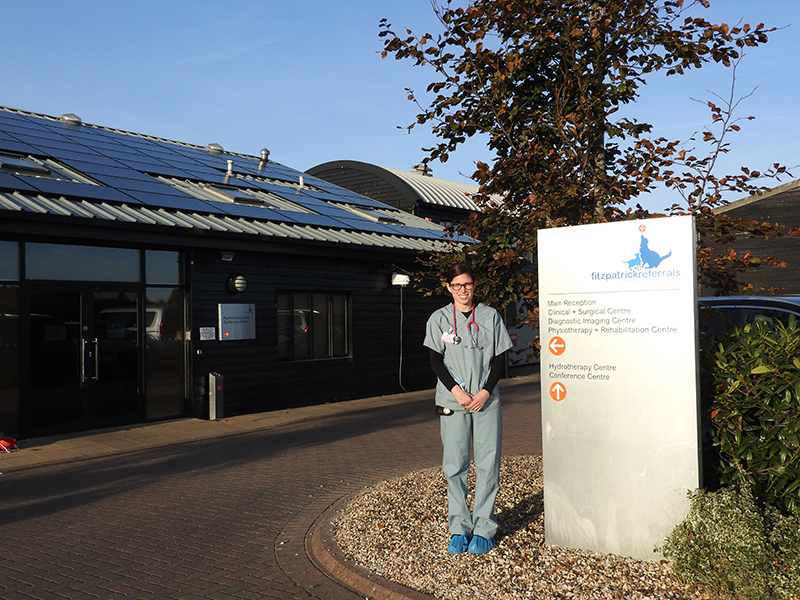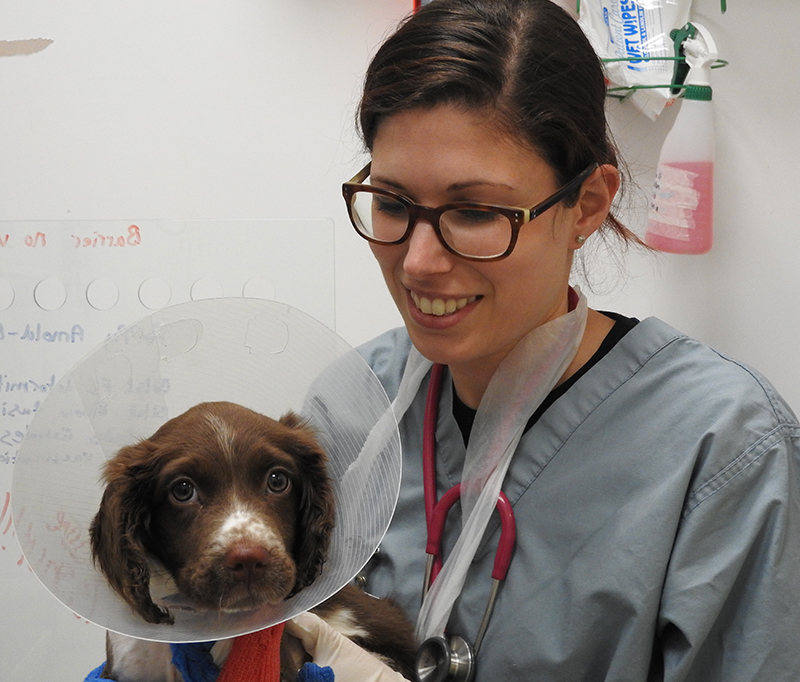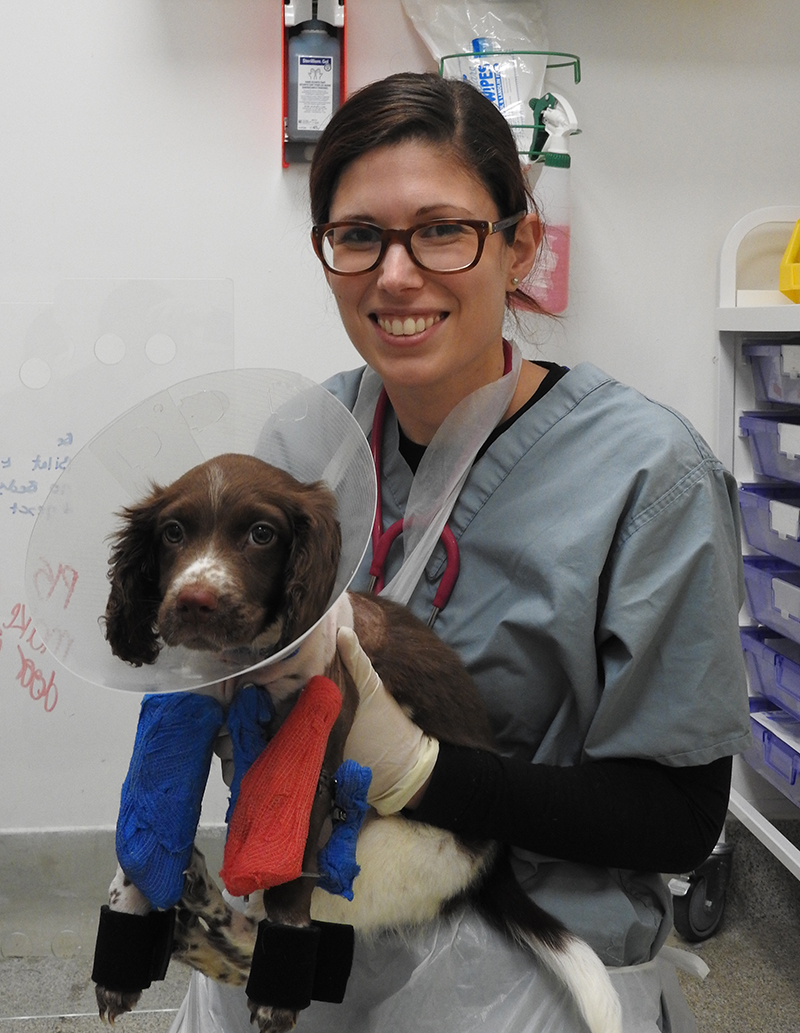I’m Lauren, a veterinary student in my final year at the University of Sydney. Before I started studying veterinary medicine I was a qualified human physiotherapist, so my veterinary interests tend to swing towards orthopaedics and rehabilitation. I’m also a SERIOUS cat-lover, so anything involving cats is typically very exciting for me.

I chose to do one of my final year work rotations at Fitzpatrick Referrals because… well, where better to see an enormous amount of cutting-edge orthopaedic surgery combined with one of the best small animal rehabilitation centres in the world? It’s an ex-physiotherapist/almost veterinarian’s dream! Having finally spent some time here it’s amazing to see how down-to-earth many of the specialists are, even when they might be performing two or more world-first procedures in a day as well as the routine procedures done on a daily basis.
The patients you see are equally stars, whether it’s a 12-week-old puppy with congenital dislocation of both elbows learning to walk on her forelimbs for the first time after corrective surgery, or a 14-year-old cat have pain-free movement restored with spinal decompression surgery after years of chronic problems. These are the patients whose stories stick with you, because they’re the difficult cases that others may deem “untreatable”. So perhaps one of the best parts of my experience at Fitzpatrick Referrals has been seeing (the often incredibly innovative) treatment of the “untreatable”, and more importantly, seeing these patients do well and regain their quality of life.

My advice for any students wanting the Fitzpatrick Referrals experience is: see EVERYTHING and talk to EVERYONE. Go into the imaging suite and chat with the radiographers. Spend some time with the physiotherapists and see how they assess patients. Visit the Fitzpatrick Referrals Oncology and Soft Tissue hospital in Guildford and see the procedures they perform there. Talk to the nurses and find out why they’re doing things the way they are. Every single person working in the organisation has valuable knowledge to share.
Having seen what the combination of advanced surgery and dedicated physiotherapy can do for animals with profound disabilities, I’ve been thoroughly inspired. My current dream is to one day open a practice specialising in rehabilitation and pain management for animals, but until then it’s back to Australia for graduation!
Joints, nerves and wagging tails: A day in the life of a student at Fitzpatrick Referrals
8:30am: Every day starts with “rounds”, where the interns discuss each of their hospital inpatients with the other vets, nurses and physiotherapy team. It’s quite incredible how the interns know every tiny detail of their patient’s history, and how they’ve been doing in hospital. This morning we have a long discussion about how best to care for the skin of one of our canine patients who has a spinal injury.
9:30am: It’s time to hit the floor! The prep room is the hub of the practice where animals are examined, anaesthetised and prepped for imaging and surgery. It’s always very busy here, often with up to 10 patients at a time being prepped and monitored by the many nurses and interns, but Kim (today’s floor manager) has everything under control. I assist one of the nurses with anaesthetising, intubating and monitoring a very sweet chocolate Labrador who needs a CT scan for arthritis in her hips.
10:30am: A tiny Chihuahua with long-term knee problems is finally having the corrective surgery she needs, which should stop her kneecap from constantly dislocating in the future. Despite a little pop quiz on muscles of the hind limb from Miguel, the surgeon, I enjoy the chance to watch surgery up close and if I’m very lucky, scrub in to help!
11:30am: A visit to the radiographers down the hallways to watch an MRI. An elderly cat with hind limb weakness is suspected to have chronic disc disease and MRI is the best method for picking this up. As back problems are rare in cats compared with their canine counterparts this is a unique opportunity for me to see a case like this.
1pm: Up to the lunchroom for a bite – I eat quickly so as not to miss any of the action happening downstairs!
2pm: Noel has finished his consults for the morning and so it’s time for him to start his surgical cases. He’ll typically operate on 3-4 cases per night and they’re often incredibly complex. I’ve learned that it’s not unusual for two world-first procedures to be performed in a single evening!
6pm: This evening’s highlight is one of Noel’s cases: Poppy, a 12-week-old English Springer Spaniel puppy born with deformities on both forelimbs which has left her unable to walk. Despite her disabilities, Poppy is winning the hearts of all of the staff with her beautiful green eyes and constantly wagging tail. After CT scans show congenital dislocation of both elbows, Noel carries out his brilliant surgery to fixate her limbs in a normal position. The bandages on her legs end up as big as she is, but clever Poppy soon learns to support her weight on them!
10pm: Surgeries are finally wrapped up for the evening. It’s time to go home and get some sleep in preparation for another excitement-filled day tomorrow!
Find out more about visiting Fitzpatrick Referrals for Extra Mural Studies (EMS)









